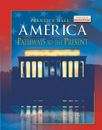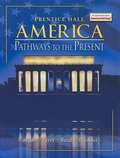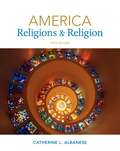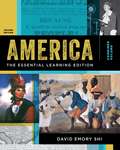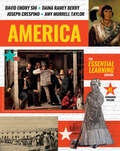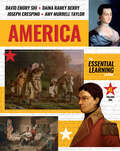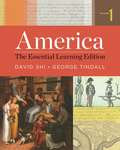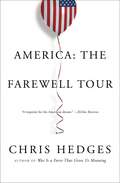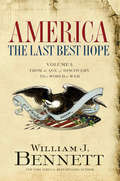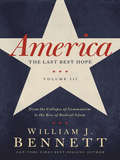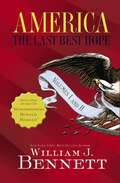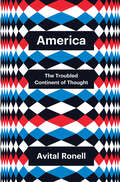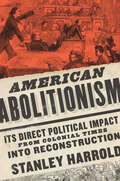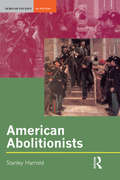- Table View
- List View
America: Land I Love
by Kurt A. GrussendorfThe people were living in the New World long before the Europeans discovered it. Over four thousand years ago, after the great Flood of Noah's day, God caused the people of the world to speak many different languages and scattered them from the tower of Babel "upon the face of all the earth."
America: Modern American History
by Andrew Cayton Elisabeth Israels Perry Linda Reed Allan M. WinklerTextbook on modern American history.
America: Modern American History
by Andrew Cayton Elisabeth Israels Perry Linda Reed Allan M. WinklerThe book covers American history in several chapters. Each chapter covers timelines, summarizing the main idea question, organizing information activity, critical thinking questions, writing activity and historical events.
America: New People, New Places)
by Wright Group/McGraw-HillThis is a leveled reader from the Lead 21 program for comprehensive K-5 core literacy. This is the History and Culture unit for 5th graders.
America: Pathways To The Present
by Andrew Cayton Elisabeth Israels Perry Linda Reed Allan M. WinklerMuch of American history can be better understood if events are viewed as part of a larger pattern. The themes and features throughout this book identify the larger patterns and the connections between events across time.
America: Pathways To The Present
by Andrew Cayton Linda Reed American Heritage Publishing Staff Elisabeth Perry Allan WinklerThis volume focuses on the events from the Civil War through today. The text includes a substantive review unit early American history to facilitate a quick, effective start to the study of modern times.
America: Pathways to the Present
by Andrew Cayton Elisabeth Israels Perry Linda Reed Allan M. WinklerA concise book on the history of America covering the period from the Origins of a New Society to 1754, Balancing Liberty and Order, 1753-1820, An Emerging New Nation, 1783-1855, Division and Uneasy Reunion, 1846-1877,Expansion: Rewards and Costs, 1850-1915,The United States on the Brink of Change, 1890-1920, Boom Times to Hard Times, 1920-1941, Hot and Cold War, 1931-1960, A Period of Turmoil and Change, 1950-1975,and Continuity and Change, 1969 to the Present.
America: Pathways to the Present
by Andrew Cayton Elisabeth Israels Perry Allan M. WinklerThis book provides in-depth, balanced content covering the beginnings of U.S. history through the present.
America: Pathways to the Present (Survey Edition)
by Andrew Cayton Elisabeth Israels Perry Linda Reed Allan M. WinklerHistory textbook.
America: Religions and Religion (5th Edition)
by Catherine L. AlbaneseAlbanese (emerita, comparative religions, U. of California--Santa Barbara) introduces students to the variety of religions in the US, and to the theories and practices of studying religion. She considerably shortened and revised the 2007 fourth edition to account for changes in classes and students, and for this fifth takes account of changes in the religious landscape since then--including findings from the 2010 census. She covers the original cast, new-made in America, patterns of expansion and contraction, and American religion and American identity. Among specific topics are tradition and change among Native Americans, the presence of Roman Catholicism, the protestant churches and the mission mind, African American religion and nationhood, 19th-century new religions, Eastern peoples and Eastern religions, and many centers meeting.
America: The Essential Learning Edition
by David E. ShiLively yet concise, The Essential Learning Edition of America blends Shi and Tindall s unrivalled narrative style with innovative pedagogy to help students understand major historical developments and strengthen critical interpretive skills. Online adaptive learning tools enhance and assess students mastery of the core objectives from the text."
America: The Essential Learning Edition (Fourth Edition) (Vol. Combined Volume)
by David E. Shi Daina Ramey Berry Joe Crespino Amy Murrell TaylorA best-selling narrative history enters a new generation The beloved and best-selling America: A Narrative History family of books has been used by millions of students because of its enthralling storytelling that brings history to life. Award-winning teachers and scholars Daina Ramey Berry (University of California, Santa Barbara), Joseph Crespino (Emory University), and Amy Murrell Taylor (University of Kentucky) join lead author David Shi (Furman University) to enhance the balanced narrative with a focus on the diverse experiences of women in American history. Seamlessly integrated into the reading experience, new tools help students to read at the college level and engage with the building blocks of history: primary sources. This purchase offers access to the digital ebook only.
America: The Essential Learning Edition (Fourth Edition) (Vol. Volume 1)
by David E. Shi Daina Ramey Berry Joe Crespino Amy Murrell TaylorA best-selling narrative history enters a new generation The beloved and best-selling America: A Narrative History family of books has been used by millions of students because of its enthralling storytelling that brings history to life. Award-winning teachers and scholars Daina Ramey Berry (University of California, Santa Barbara), Joseph Crespino (Emory University), and Amy Murrell Taylor (University of Kentucky) join lead author David Shi (Furman University) to enhance the balanced narrative with a focus on the diverse experiences of women in American history. Seamlessly integrated into the reading experience, new tools help students to read at the college level and engage with the building blocks of history: primary sources. This purchase offers access to the digital ebook only.
America: The Essential Learning Edition (Fourth Edition) (Vol. Volume 2)
by David E. Shi Daina Ramey Berry Joe Crespino Amy Murrell TaylorA best-selling narrative history enters a new generation The beloved and best-selling America: A Narrative History family of books has been used by millions of students because of its enthralling storytelling that brings history to life. Award-winning teachers and scholars Daina Ramey Berry (University of California, Santa Barbara), Joseph Crespino (Emory University), and Amy Murrell Taylor (University of Kentucky) join lead author David Shi (Furman University) to enhance the balanced narrative with a focus on the diverse experiences of women in American history. Seamlessly integrated into the reading experience, new tools help students to read at the college level and engage with the building blocks of history: primary sources. This purchase offers access to the digital ebook only.
America: The Essential Learning Edition, Volume 1
by George Brown Tindall David E. Shi Erik Anderson Jonathan LeeLively yet concise, The Essential Learning Edition of America blends Shi and Tindall's unrivalled narrative style with innovative pedagogy to help students understand major historical developments and strengthen critical interpretive skills. Online adaptive learning tools enhance and assess students' mastery of the core objectives from the text.
America: The Farewell Tour
by Chris HedgesA profound and provocative examination of America in crisis, where unemployment, deindustrialization, and a bitter hopelessness and malaise have resulted in an epidemic of diseases of despair—drug abuse, gambling, suicide, magical thinking, xenophobia, and a culture of sadism and hate.America, says Pulitzer Prize–winning reporter Chris Hedges, is convulsed by an array of pathologies that have arisen out of profound hopelessness, a bitter despair and a civil society that has ceased to function. The opioid crisis, the retreat into gambling to cope with economic distress, the pornification of culture, the rise of magical thinking, the celebration of sadism, hate, and plagues of suicides are the physical manifestations of a society that is being ravaged by corporate pillage and a failed democracy. As our society unravels, we also face global upheaval caused by catastrophic climate change. All these ills presage a frightening reconfiguration of the nation and the planet. Donald Trump rode this disenchantment to power. In America: The Farewell Tour, Hedges argues that neither political party, now captured by corporate power, addresses the systemic problem. Until our corporate coup d’état is reversed these diseases will grow and ravage the country. A poignant cry reported from communities across the country, America: The Farewell Tour seeks to jolt us out of our complacency while there is still time.
America: The Last Best Hope (Volume I)
by William J. BennettTo resce the future, we must remember our past.With command and wit, William J. Bennett reacquaints Americans with their heritage in an engaging narrative that cuts through the cobwebs of time, memory, and prevailing cynicism. Washington, Franklin, Lincoln, Roosevelt, and others reemerge not as marble icons or dust-dry names in a textbook, but as full-blooded, heroic pioneers whose far-reaching vision forged a nation that attracted?that still attracts?millions yearning to breathe free. In this, the first volume of a "reasoned, balanced presentation of the American story," Bennett tells our nation's story, with all its triumphs and tragedies. He summons us to embrace America's cause once again as "the last best hope of earth."What others are saying:"William J. Bennett artfully and subtly makes connections between our past and current events, reminding us ... that we are intimately and immediately connected to the extraordinary Americans who have bestowed upon us our great heritage.... [T]he importance of America: The Last Best Hope probably exceeds anything Dr. Bennett has ever written, and it is more elegantly crafted and eminently readable than any comprehensive work of history I've read in a very long time. It's silly to compare great works of history to great novels, but this book truly is a page-turner.... Prepare to have your faith in, hope for, and love of America renewed." -Brad Miner, American Compass"The Role of history is to inform, inspire, and sometimes provoke us, which is why Bill Bennett's wonderfully readable book is so important. He puts our nation's triumphs, along with its lapses, into the context of a narrative about the progress of freedom. Every now and then it's useful to be reminded that we are a fortunate people, blessed with generations of leaders who repeatedly renewed the meaning of America." -Walter Isaacson, Benjamin Franklin: An American Life"For too long Americans have been looking for a history of our country that tells the story of America's triumphs as well as its tragedies. Now Bill Bennett has come forward with America: The Last Best Hope, which tells the story-fairly and fully-from 1492 to 1914. Americans who have been reading recent biographies of the Founding Fathers will love this book." -Michael Barone, US News & World Report"Bill Bennett's book will stand as perhaps the most important addition to American scholarship at this, the start of the new century. For the past fifty years American historians have either distorted American history or reduced it to a mess of boring indictments of our cultural and political heritage. With this book Bennett offers to Americans young and old an exciting and enjoyable history of what makes America the greatest nation on earth. -Brian Kennedy, president, The Claremont Institute
America: The Last Best Hope (Volume II)
by William J. BennettRespected scholar William Bennett reacquaints America with its heritage in the second volume of America: The Last Best Hope (Volume II). This engaging narrative slices through the cobwebs of time, memory, and prevailing cynicism to reinvigorate America with an informed patriotism. Like the previous volume of America: The Last Best Hope, Volume II responds to Reagan's heartfelt call for an informed patriotism, telling the riveting story of the last century's great wars, the rise of world Communism, the struggle of freedom at home and abroad, and the triumph of liberty.
America: The Last Best Hope Volumes I & II Box Set
by William BennettWilliam J. Bennett reacquaints America with its heritage in two volumes of America: The Last Best Hope.While national test scores reveal that American students know startlingly little about their history, former U.S. Education Secretary William J. Bennett offers one of the most gripping and memorable versions of the American story in print. The two volumes of Bennett's New York Times bestselling epic, America: The Last Best Hope, cover Columbus's discovery of the New World in the fifteenth century to the fall of world communism in the twentieth. Now both volumes are available in a convenient and attractive slip case-complete with a bonus audio CD, "Remembering Ronald Reagan," featuring recollections and commentary by Jeane Kirkpatrick, Edwin Meese, and others.Bill Bennett brings American history to life with stories such as: the coup d'etat quelled by a pair of reading glassesthe U.S. senator nearly caned to death on the Senate floorthe presidential pardon for hundreds of Sioux warriorsone ex-president's race to finish his memoirs and the famous humorist who helped himwhen Time magazine named Hitler man of the yearEisenhower's bold actions documenting the horrors of the HolocaustNixon's comic opera uniforms for White House guardsReagan's most famous example of just saying "No"From heroism of the Revolution to the dire hours of the Civil War, from the progressive reforms of the early 1900s to the civil rights reforms of the 1960s, from the high drama of the Space Race to the gut-wrenching tension of the Cold War, Bennett slices through the cobwebs of time, memory, and prevailing cynicism to reinvigorate America with an informed patriotism.Praise for America: The Last Best Hope"This is the American history that Abraham Lincoln has long awaited."-Harry V. Jaffa, Crisis of the House Divided"Bennett has a gift for choosing the pithy, revealing anecdote and for providing fresh character sketches and critical analyses of the leading figures. This is an American history that adults will find refreshing and enlightening and that younger readers will find a darn good read."-Michael Barone, US News & World Report "A worthy and necessary book for our time."-Michael J. Lewis, Commentary"Bennett ... has a strong sense of narrative, a flair for anecdote and a lively style. And the American story really is a remarkable one, filled with its share of brilliant leaders and tragic mistakes. Bennett brings that story to life."-Alan Wolfe, The Washington Post"The role of history is to inform, inspire, and sometimes provoke us, which is why Bill Bennett's wonderfully readable book is so important. He puts our nation's triumphs, along with its lapses, into the context of a narrative about the progress of freedom. Every now and then it's useful to be reminded that we are a fortunate people, blessed with generations of leaders who repeatedly renewed the meaning of America."-Walter Isaacson, Benjamin Franklin: An American Life"The importance of America: The Last Best Hope probably exceeds anything Dr. Bennett has ever written, and it is more elegantly crafted and eminently readable than any comprehensive work of history I've read in a very long time. It's silly to compare great works of history to great novels, but this book truly is a page-turner." -Brad Miner, American Compass"This lively book acknowledges mistakes and shortcomings, yet patriotically asserts that the American experiment in democracy is still a success story."-School Library Journal"Bill Bennett's book will stand as perhaps the most important addition to American scholarship at this, the start of the new century.... With this book Bennett offers to Americans young and old an exciting and enjoyable history of what makes America the greatest nation on earth.-Brian Kennedy, president, The Claremont Institute
America: The Later Years
by T. H. Breen Robert A. Divine George M. Fredrickson R. Hal WilliamsThis book outlines the history of United States from the first settlers to date.
America: The Troubled Continent of Thought (Theory Redux)
by Avital RonellWhat position does America occupy in the recent history of Western philosophy? At once the destination for a series of fantasies and the place from which a new relationship to thought originated, America incarnates a dark continent whose strangeness and singularity has driven thinkers outside of their own philosophical comfort zone – often forcing them to show anger, anxiety or desire towards what they considered a challenge or a threat. This book provides a mapping of this complex relationship between America and philosophy through a series of examples drawn from a wide range of authors, from Freud and Heidegger to Adorno, Derrida and many others. It also examines the way American thinkers themselves have imported, used and abused philosophical views coming from Europe, often transforming them into something other than what they were. Is then philosophy an anti-American discourse, or America an anti-philosophical country? Or is it, rather, that America provokes philosophy from a place where its own history affirms the impossibilities, paradoxes and contradictions of philosophy itself? At a time when the syntagm “America” has come to crystallize a certain understanding of the world order, interrogating the place that it occupies in our intellectual tradition is also a way to engage critically with the violence attached to it. “America” is a syntagm for violence, but this violence might very well be different than we thought.
American Abolitionism: Its Direct Political Impact from Colonial Times into Reconstruction (A Nation Divided)
by Stanley HarroldThis ambitious book provides the only systematic examination of the American abolition movement’s direct impacts on antislavery politics from colonial times to the Civil War and after. As opposed to indirect methods such as propaganda, sermons, and speeches at protest meetings, Stanley Harrold focuses on abolitionists’ political tactics—petitioning, lobbying, establishing bonds with sympathetic politicians—and on their disruptions of slavery itself.Harrold begins with the abolition movement’s relationship to politics and government in the northern American colonies and goes on to evaluate its effect in a number of crucial contexts--the U.S. Congress during the 1790s, the Missouri Compromise, the struggle over slavery in Illinois during the 1820s, and abolitionist petitioning of Congress during that same decade. He shows how the rise of "immediate" abolitionism, with its emphasis on moral suasion, did not diminish direct abolitionists’ impact on Congress during the 1830s and 1840s. The book also addresses abolitionists’ direct actions against slavery itself, aiding escaped or kidnapped slaves, which led southern politicians to demand the Fugitive Slave Law of 1850, a major flashpoint of antebellum politics. Finally, Harrold investigates the relationship between abolitionists and the Republican Party through the Civil War and Reconstruction.
American Abolitionists (Seminar Studies)
by Stanley HarroldThis book, the latest in the Seminar Studies in History series, examines the movement to abolish slavery in the US, from the origins of the movement in the eighteenth century through to the Civil War and the abolition of slavery in 1865. Books in this Seminar Studies in History series bridge the gap between textbook and specialist survey and consists of a brief "Introduction" and/or "Background" to the subject, valuable in bringing the reader up-to-speed on the area being examined, followed by a substantial and authoritative section of "Analysis" focusing on the main themes and issues. There is a succinct "Assessment" of the subject, a generous selection of "Documents" and a detailed bibliography. Stanley Harrold provides an accessible introduction to the subject, synthesizing the enormous amount of literature on the topic. American Abolitionists explores "the roles of slaves and free blacks in the movement, the importance of empathy among antislavery whites for the suffering slaves, and the impact of abolitionism upon the sectional struggle between the North and the South". Within a basic chronological framework the author also considers more general themes such as black abolitionists, feminism, and anti-slavery violence. For readers interested in American history.

